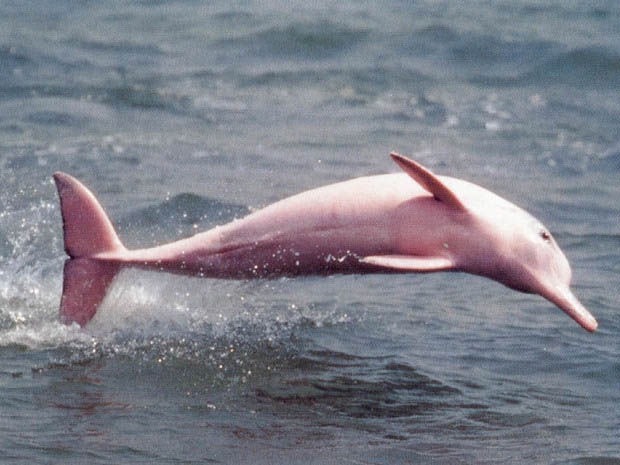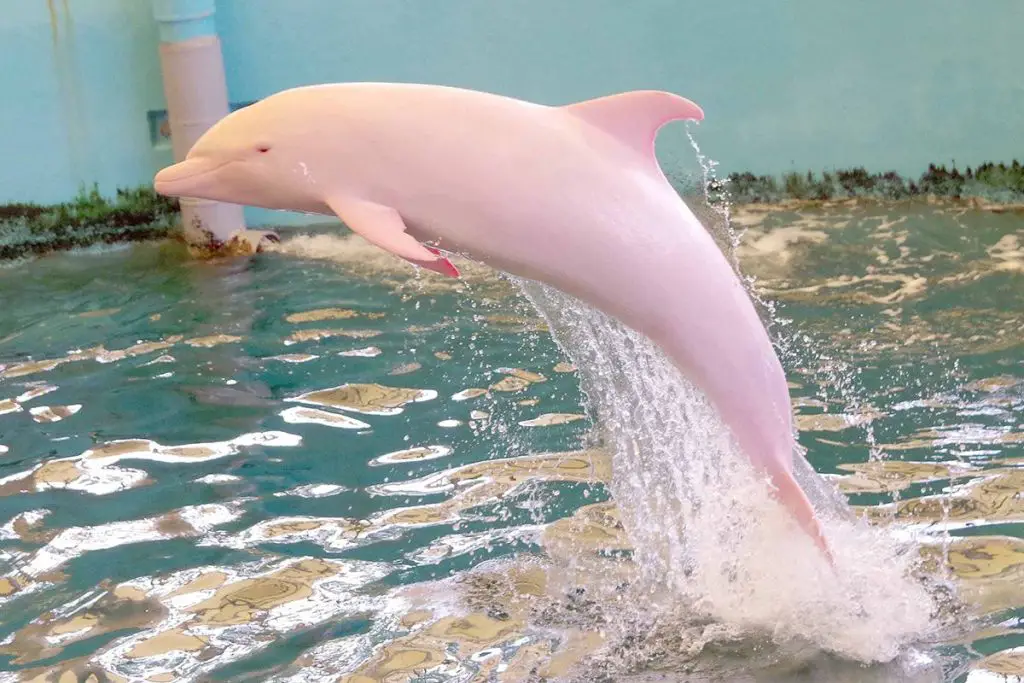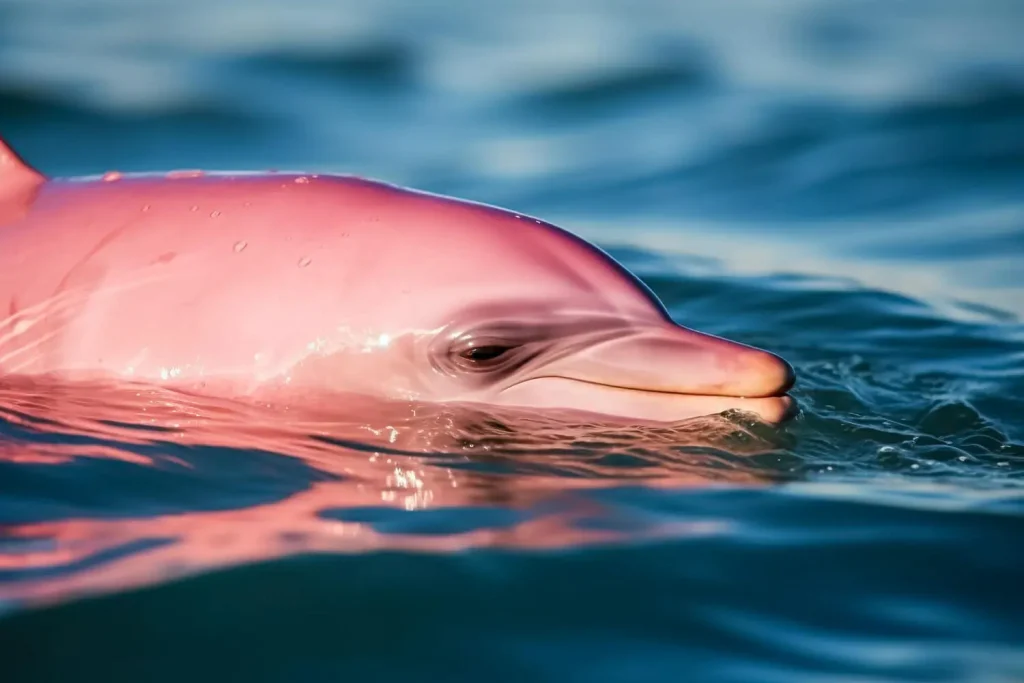Researchers snapped a photo of an unusual pink Irrawaddy dolphin calf in a pod of Indo-Pacific humpback dolphins swimming off the coast of Cambodia.
Pink dolphins
The Irrawaddy dolphin (Orcaella brevirostris) calf was probably with its mother in a pod of Indo-Pacific humpback dolphins (Sousa chinensis). Irrawaddy dolphins are dark gray with flat snouts, while Indo-Pacific humpback dolphins are pink with long noses, so the calf and mother stick out like wank thumbs.
Researchers from Marine Conservation Cambodia (MCC) announced the sighting on May 31, posting on Facebook that the interaction was “extremely unusual” because the two species usually only meet when foraging in the same area.
Becky Chambers, lead scientist for MCC’s Cambodian Marine Mammal Conservation Project, told LiveScience that her team was really excited to spot the calf, but they weren’t sure why the two species were together.
“It’s a bit of a mystery,” Chambers said. “These are highly threatened populations and the fact that they are having interactions, at the moment, I would say is neither good nor bad.”
Irrawaddys, known for spitting water from their mouths and helping humans catch fish, are at risk of extinction, in part because they become entangled in fishing gear. Researchers don’t know how many Irrawaddys remain in the wild, but their population is severely fragmented, according to the IUCN Red List.

Chambers and his colleagues were conducting investigations off southern Cambodia on March 12, when they first encountered the young Irrawaddy dolphin calf. “We see young people quite often, but this was a newborn, which is an event in itself,” he said.
Irrawaddys are known to hybridize with d. Indo-Pacific humpback whales, but it is extremely rare and this calf had all the physical characteristics of a baby Irrawaddy dolphin, according to the Facebook post. This means that he was probably born to two Irrawaddy parents.
Both species can engage in alloparenting, that is, providing care to young that are not direct descendants, which can, in rare cases, extend to other species. However, it is unclear whether the Indo-Pacific humpback whales were trying to care for or harm the calf.
Chambers noted that those in the Indo-Pacific may have attempted to separate the mother from the calf in an act of aggression, perhaps motivated by competition. “I’m not sure if it was an aggressive interaction or not,” she said.
But the calf appears to have survived its time with Indo-Pacific humpback dolphins. On April 23, one of Chambers’ colleagues likely spotted the calf again. This time, the researcher followed a lone Indo-Pacific humpback dolphin, which to their surprise, swam towards a pod of Irrawaddy dolphins.
Why the Indo-Pacific humpback whale joined a group of Irrawaddy dolphins is also unclear, but that group of Irrawaddy dolphins had a calf, and Chambers believes it was the same one that was spotted in group of Indo-Pacific humpback whales.
“They didn’t have a good camera, so no photos could be taken on that occasion, but it’s likely the same individual, which is good because it means the calf is still alive,” Chambers said.
dolphins raid crab pots
Dolphins have learned how to outsmart crab fishermen by stealing bait from their pots, and new footage has captured this unique behavior for the first time.
Bottlenose dolphins watch crab fishermen load their nets with fish and throw them into the ocean off Koombana Bay, Western Australia. Then the animals crawl into the nets and detach the bait from the hooks in the crab pots.
Crab fishermen tried placing bait under pots or in bait boxes to discourage thieves, but the dolphins soon learned how to tip them over or open the boxes.
Conservationist Rodney Peterson first noticed this behavior two years ago and was concerned that the dolphins were becoming entangled in nets or eating unhealthy food.
He turned to the Dolphin Discovery Center in the town of Bunbury, which has installed five cameras to film the animals in action.
“Dolphins are very intelligent and brilliant observers and are always looking for food. Often, when they see an opportunity, they will take it, especially mothers with calves,” director Axel Grossmann, who volunteers at the Dolphin Discovery Center alongside wildlife conservationists. , he said.
They opened the jars in different ways. “The simplest version is that the dolphin grabs the bait that is on a metal hook or pin inside the crab pot. So essentially, the dolphins pull the fish off the pin or split it into edible pieces,” Grossmann said.

To discourage the mammals, some fishermen placed bait under crab pots, which meant the dolphins had to use more sophisticated techniques to obtain it. “They learned to turn crab pots using their rostrum (jaws) and body, so they can access the bait more easily,” Grossmann said.
They even opened bait boxes, plastic containers used to hold bait. “Some blacksmith dolphins have learned to open the lock with their beak or teeth, and once they open the lid of the box, they grab the fish,” Grossmann said.
“We and some crab fishermen developed a mesh bait case with a metal hook that held the bait tightly closed,” Grossmann said. “The dolphins learned that it was not accessible, so they swam away. This means we will have healthier dolphins and happier crab fishermen.”
Dolphins steal food for several reasons, Grossmann said.
“If they are hungry, they may work harder to figure out how to get additional food sources such as crab bait, especially in an area highly frequented by humans. Essentially, the dolphins see humans putting food on a plate in their backyard,” he said.
But not all dolphins do this, so there may be other reasons why the animals chase crab bait.
“We believe it’s a mixture of interest, an easy way to catch a fish, learned adaptive behavior and maybe even a little fun,” Grossmann said.
The strange reason why dolphins drink each other’s pee
Dolphins get to know their friends by tasting their pee, according to a new study. By sampling sips of each other’s urine, the dolphins demonstrated a type of social recognition that begins with an exchange of unique whistles for specific individuals, much like human names.
Scientists have long known that dolphins identify themselves using so-called signature whistles, which are different for each dolphin, and that they address each other by imitating those whistles. But the researchers were uncertain whether this copy demonstrated that dolphins associate distinctive whistles with individual identity or with a more general concept such as “friend.”
Recently, scientists learned that not only do bottlenose dolphins demonstrate name recognition, but they also replicate this recognition with another sense: taste.
By tasting each other’s urine and recognizing its source, the dolphins demonstrated that they could track dolphin identities using two types of sensory input. This means that, according to the new study, the animals could create and store a mental concept of other dolphins.

The researchers found that they make this type of identification by tasting pee while investigating whether the animals actually call each other by name when they copy whistles. The scientists conducted what is known as a cross-modal study, in which experiments test whether an animal can recognize an object or another animal across multiple signals received from different senses.
Scientists have previously used such experiments on a wide range of animals, including fish and monkeys. But communication systems in most animals lack recognizable sounds as labels for individuals, such as distinctive whistles, the researchers wrote.
Finding a second sense in dolphins that could be tested under laboratory conditions was challenging. Testing dolphins’ vision or echolocation “would involve moving giant monitors or even the dolphins themselves, which is impossible,” said study lead author Jason Bruck, a biologist at Stephen F. Austin State University in Texas. But dolphins are known to swim through the urine plumes of others, with their mouths open, and they might do so to gain social information “the way a dog sniffs a fire hydrant,” Bruck said.
“Except they would have to do it with taste, not smell,” since cetaceans don’t have olfactory bulbs, he added.
The researchers found that it took them about three times longer to sample the urine of unfamiliar dolphins than familiar ones. This suggested that the animals could identify known mates based on taste.
To test the persistence of identification across the senses, the researchers paired the whistle recordings with urine: in some pairings, the urine came from the whistler, while in others it was produced by a different dolphin. The scientists then introduced them to the sound of a whistle and the taste of a urine sample.

When the pee matched the whistle, the listening dolphins lingered closer to the playback speakers. This indicated that the animals recognized the coherence of signals perceived by two senses – taste and hearing – and that both taste and sound came from the same dolphin.
These findings mean that for dolphins, whistles represent the dolphin’s specific identity in the minds of other dolphins, including the taste of that dolphin’s pee.
“We now know that when a dolphin makes that distinctive whistle, it is actually referring to that dolphin that it is copying,” Bruck said. “They’re using those boos in much the same way we use names.”
Future studies could investigate the mechanisms underlying this ability dolphins newly discovered, Bruck said. Taste-guided identification of dolphins can be guided by lipid recognition; if so, dolphin research could reveal a lipid-sensitive taste bud that is larger and more robust than the human variety and therefore easier to study. Such a finding could inform obesity research in humans, Bruck said.
These findings could open up new avenues for dolphin research, Bruck added. “Transmitting social information from dolphin to dolphin [è] as easy as [utilizzare] an underwater speaker” and could offer insights into “how dolphins perceive each other as individuals,” he said.
The results were published in the journal Science Advances.
#Pink #dolphins #spotted #babies